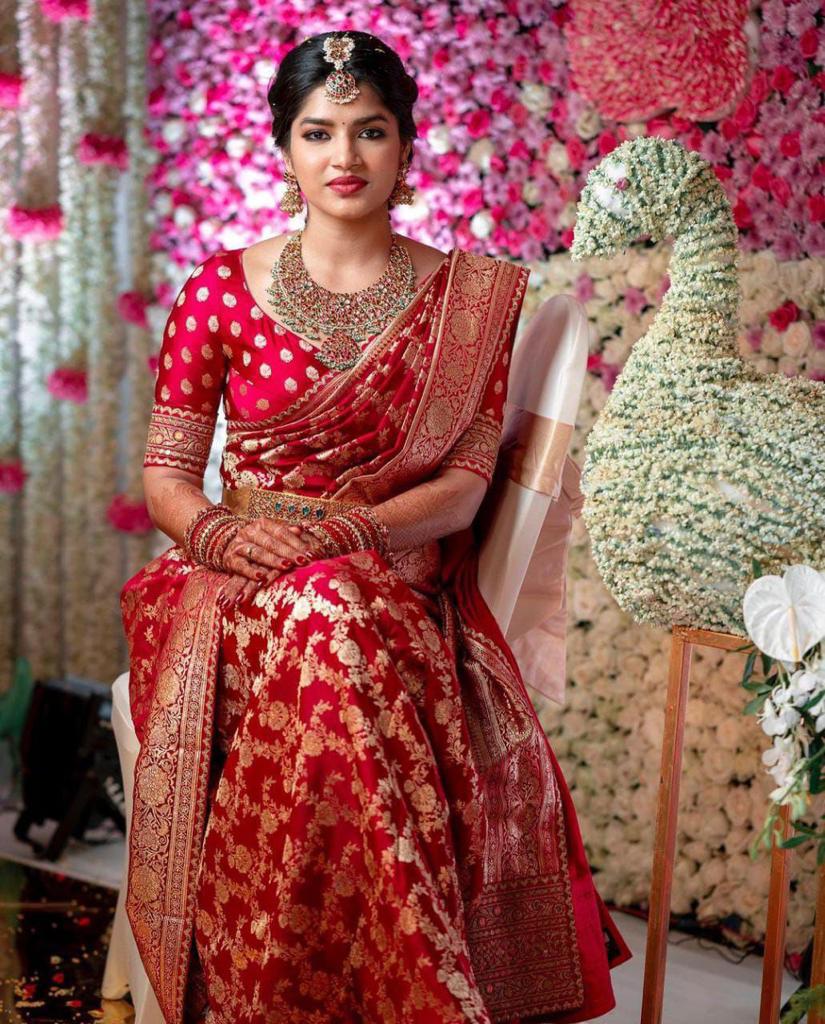
Banarasi Silk Sarees, renowned for their exquisite craftsmanship and luxurious texture, are a quintessential part of Indian heritage. Originating from the holy city of Varanasi (also known as Benares), these sarees are celebrated for their intricate designs and opulent fabric. Among the most coveted attire for Indian brides, Banarasi Silk Sarees, especially Bridal Silk Sarees, hold a special place. While often compared with Traditional Kanjivaram Sarees from Tamil Nadu, Banarasi sarees boast unique features that distinguish them in the world of Indian textiles. In this article, we will delve into the different types of Banarasi Silk Sarees and their unique characteristics.
The Rich Heritage of Banarasi Silk Sarees
Banarasi Silk Sarees trace their roots back to the Mughal era, when Persian motifs fused with Indian artistry to create elaborate brocades. These sarees are made from finely woven silk and are embellished with intricate designs using gold and silver threads, making them a symbol of luxury and elegance.
Types of Banarasi Silk Sarees
Banarasi Silk Sarees come in various types, each characterized by its weaving technique, design, and material. The primary types include Pure Silk (Katan), Shattir, Organza (Kora), and Georgette. Let’s explore these in detail:
1. Katan Silk Banarasi Sarees
Katan Silk is pure silk, known for its strength and softness. These sarees are made using pure silk threads that are twisted and woven into fabric. The hallmark of Katan Silk Banarasi Sarees is their solid-colored background adorned with elaborate motifs in gold or silver zari. They are perfect for bridal wear due to their rich texture and regal appearance.
2. Shattir Banarasi Sarees
Shattir is a contemporary form of Banarasi saree, designed to cater to the evolving tastes of modern women. These sarees are lightweight and often feature a combination of silk and synthetic fibers, making them more affordable than traditional pure silk sarees. Shattir Banarasi Sarees maintain the essence of Banarasi artistry while being accessible for everyday wear.
3. Organza (Kora) Banarasi Sarees
Organza, also known as Kora, is a thin, plain-woven fabric made from silk. Organza Banarasi Sarees are known for their sheer texture and lightweight feel. They are often decorated with elaborate zari work, adding a touch of glamour while maintaining an airy lightness. These sarees are ideal for festive occasions and summer weddings, offering elegance without the heaviness of traditional silk.
4. Georgette Banarasi Sarees
Georgette is a lightweight, sheer fabric with a slightly crinkled texture. Georgette Banarasi Sarees are prized for their fluid drape and versatility. They often feature delicate embroidery and light zari work, making them perfect for both casual and formal events. The blend of tradition and modernity in Georgette Banarasi Sarees appeals to younger generations seeking elegance with a contemporary touch.
Unique Features of Banarasi Silk Sarees
Banarasi Silk Sarees are distinguished by several unique features that set them apart from other silk sarees like Traditional Kanjivaram Sarees:
1. Intricate Zari Work
One of the defining characteristics of Banarasi Silk Sarees is the intricate zari work. Zari, which involves weaving threads of gold or silver into the fabric, creates elaborate patterns and motifs. The designs often include floral patterns, paisleys, and Mughal-inspired motifs like jhallar (a string of leaves) along the border.
2. Opulent Fabric
The fabric of Banarasi Silk Sarees is typically rich and heavy, exuding a luxurious feel. The use of pure silk and the addition of metallic threads contribute to the saree’s opulence, making it a favored choice for bridal silk sarees.
3. Diverse Patterns and Designs
Banarasi sarees boast a diverse range of patterns and designs. From the traditional butidar (small bootis or motifs) and jangla (intricate patterns across the fabric) to the contemporary abstract designs, Banarasi sarees cater to various tastes and preferences. This diversity ensures that there is a Banarasi saree for every occasion, whether it’s a wedding, festival, or formal event.
4. Cultural Significance
Banarasi Silk Sarees are not just garments; they are a part of India’s cultural heritage. The sarees are often handed down through generations, symbolizing tradition and continuity. They play a crucial role in Indian weddings, with brides often opting for Banarasi Bridal Silk Sarees to mark their special day.
5. Comparative Elegance with Kanjivaram Sarees
While Traditional Kanjivaram Sarees from Tamil Nadu are known for their bold colors and temple-inspired designs, Banarasi Silk Sarees stand out with their intricate Mughal motifs and fine weaving. Both types of sarees are highly regarded, but Banarasi sarees are often considered more delicate and detailed in their artistry.
Conclusion
Banarasi Silk Sarees are a testament to India’s rich textile heritage and skilled craftsmanship. Their various types, from Katan to Georgette, each bring a unique flair, making them suitable for a wide range of occasions. The intricate zari work, luxurious fabric, and cultural significance of Banarasi sarees ensure their continued popularity, especially as Bridal Silk Sarees. While they share the spotlight with Traditional Kanjivaram Sarees, Banarasi Silk Sarees hold their own with unmatched elegance and historical depth, making them a timeless choice for any wardrobe.



